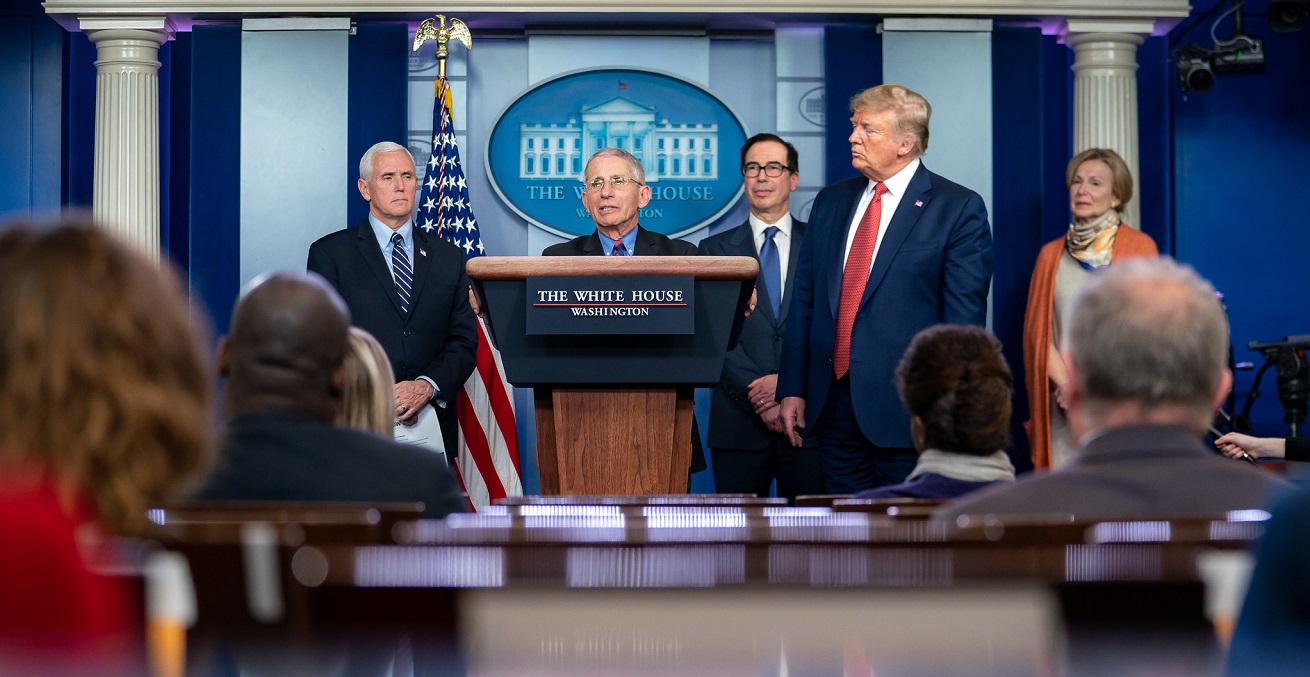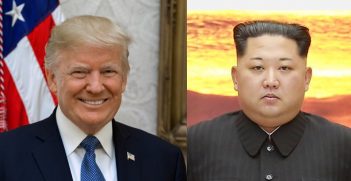COVID-19: A Black Swan Event in the 2020 US Presidential Election

The COVID-19 pandemic is happening against the backdrop of the 2020 US presidential elections. The virus seems to have undone all the gains that Trump was counting on to be the foundation of his 2020 re-election bid.
Throughout his presidency, Donald Trump had been riding on his stable popularity rating, economic growth, a low unemployment rate, and tough foreign policy measures. Trump has succeeded in containing the Islamic State, bringing North Korea to the negotiating table, and taking on China’s assertiveness directly. But re-election will not come easily. COVID-19 has emerged as a Black Swan – an unpredictable catastrophic event with severe consequences – in the 59th US presidential election.
Handling of COVID-19 brought Trump’s approval rating down below 40 percent in February 2020. But this trend has reversed in March. A weekly Economist/YouGov survey published on 26 March shows an eight percent increase in Trump’s approval rating. An ABC News/Ipsos poll displays a 12 percent increase from its previous poll, taking Trump’s approval to 55 percent. And a poll conducted by Morning Consult on March 20 reveals a 53 percent approval rating for Trump’s leadership in managing the COVID-19 outbreak. These increases are attributed to Trump’s sombre and serious approach, economic stimulus package, and lockdown measures after a spike in the number of COVID-19 cases and the death toll in the US.
A War-time President
However, Trump’s “China Virus” remarks and refashioning of himself as a war-time president are also responsible for the increase in his approval rating. Trump’s attack on China for hiding the truth about the severity of outbreak invoked American nationalism and the US-China geopolitical rivalry. This is a new dimension of the economic “America First” nationalism, for which a resurgent China, a would-be hegemon challenging American global leadership, has been the main target. Combined with its authoritarian regime and poor records on human rights, and despite US-China bilateral trade relations, China has come to be viewed negatively in the US.
References to COVID-19 as the “China Virus” or “Wuhan Virus” have been repeatedly used by prominent Republicans. Though Trump claims his “China Virus” remarks are not racist and are aimed at the Chinese government’s irresponsible handling of the outbreak, these remarks have resulted in reported incidents of racial slurs and physical mistreatment of Asian-Americans.
As the World Health Organization (WHO) warns of the US becoming the next epidemic centre, President Trump and prominent Republicans, including Secretary of State Mike Pompeo, have attacked China for suppressing the truth about the severity of the COVID-19 outbreak and delayed containment actions, and promoting conspiracy theories against the US. The role of WHO Director-General Tedros Adhanom Ghebreyesus is also under the scanner for underplaying the severity of the pandemic. Trump has attacked the WHO for being China-centric and blamed Ghebreysesus for working at the behest of China and sheltering the Communist regime, leading to the late declaration of COVID-19 as a pandemic.
Trump’s “war-time president” mantle amidst the COVID-19 crisis is seen in his efforts to increase his popularity for his re-election mission. In fact, amidst the current crisis, many heads of government have referred to the fight against COVID-19 as a war. Trump’s war-time president allegory is not unprecedented. In the past, US presidents have refashioned themselves as war-time presidents to deal with crises since President Lyndon B. Johnson’s War on Poverty in the 1960s. In the 1970s, Jimmy Carter elevated his energy conservation mission to the moral equivalent of war, and in the 1980s, Ronald Reagan waged a War on Drugs. Going into the 2020 elections, Trump’s war-time presidency will be evaluated by his war-level executive competency to contain the outbreak.
Inconsistent Approach: Question on Executive Competency
Trump’s late response has been questioned, and certainly the beginning lacked a war-time president’s efforts. Compared with South Korea, which has contained the outbreak after reporting its first case on 20 January, the same day as the US, the US approach has been slow and inconsistent, raising questions about Trump’s leadership. Ignoring the severity of outbreak, President Trump first called it a hoax and shrugged off its seriousness, expecting businesses to resume trading by Easter. But as confirmed cases and the death toll began to rise, and with projections that the US would surpass all other countries and see more than 100,000 deaths in a best case scenario, Trump has begun to realise the gravity of the situation.
To contain the pandemic, Trump has approved the world’s biggest economic stimulus package of US$ 2 trillion, called for increased production of ventilators, and implemented lockdown and social distancing measures. The US has now tested the highest number of people tested in the world, though the proportion of the population being tested is not adequate when compared with the other developed nations. He has adopted a more solemn approach and changed his framing of the situation from a disease that would disappear like a miracle to a pandemic warranting war-scale containment effort. With fatalities in the coming weeks projected to be on the scale of the WWII attacks on Pearl Harbor, questions are being raised about the lack of coordination, delayed containment action, Trump’s executive competency, and the absence of a universal healthcare system in the US.
A Black Swan Event n the US Election
COVID-19 may prove to be a black swan event, particularly when compared with the 1920 US presidential election 100 years ago. Under Democratic President Woodrow Wilson, the United States entered the First World War alongside the Allied powers. But another foe was the Spanish Flu that occurred during the First World War and spread throughout Europe with the soldiers’ movements. The Spanish Flu killed an estimated 50-100 million people across the world, including many American citizens as US soldiers brought the disease back home.
Despite being the victorious side, the emergence of the US as a world power, and a leading role in the post-war negotiations, Wilson’s incumbent Democratic Party could not win the 1920 presidential election. Republican presidential candidate Warren G. Harding, a senator from Ohio, sailed to a landslide victory with his slogan of “Return to Normalcy.” With Wilson disabled after suffering a stroke in 1919, Harding defeated Democratic candidate James M. Cox who was the governor of Ohio. Instead of focusing on Cox, Harding’s campaign emphasised mistakes made by President Wilson in handling the flu.
Harding’s “Return to Normalcy” echoed the American people’s disenchantment with Progressive Era social unrest, the war attrition that was caused by the US international engagement in the wake of the Allied Powers victory, and Wilson’s Treaty of Versailles, which was unpopular in the US. But it was Spanish Flu that emerged as one of the significant issues in the 1920 election. Deaths due to the flu, combined with other factors, helped Harding to defeat the Democratic candidate.
In 2020, the incumbent President Trump is suddenly facing COVID-19 as a black swan event which might see opposing Democratic Party candidate Joe Biden upsetting Trump’s winning probabilities and momentum. But Biden has been absent from the public sphere as the nation contains the pandemic. So far, Trump’s “China Virus” and “war-time president” rhetoric, his handling of the outbreak, and the economic stimulus packages have kept his approval rating out of danger zone. Trump’s successful handling of the COVID-19 outbreak will be the key to his second term in the White House.
Dr Ashok Sharma is a Visiting Fellow at the University of New South Wales Canberra at the Australian Defence Force Academy and an Adjunct Associate Professor at the University of Canberra. He is also the Deputy Chair of the New Zealand Institute of International Affairs Auckland Branch. Ashok’s latest books are India’s Pursuit of Energy Security: Domestic Measures, Foreign Policy and Geopolitics (SAGE Publications, 2019) and Indian Lobbying and its Influence in US Decision Making: Post-Cold War (SAGE, 2017).
This article is published under a Creative Commons Licence and may be republished with attribution.





